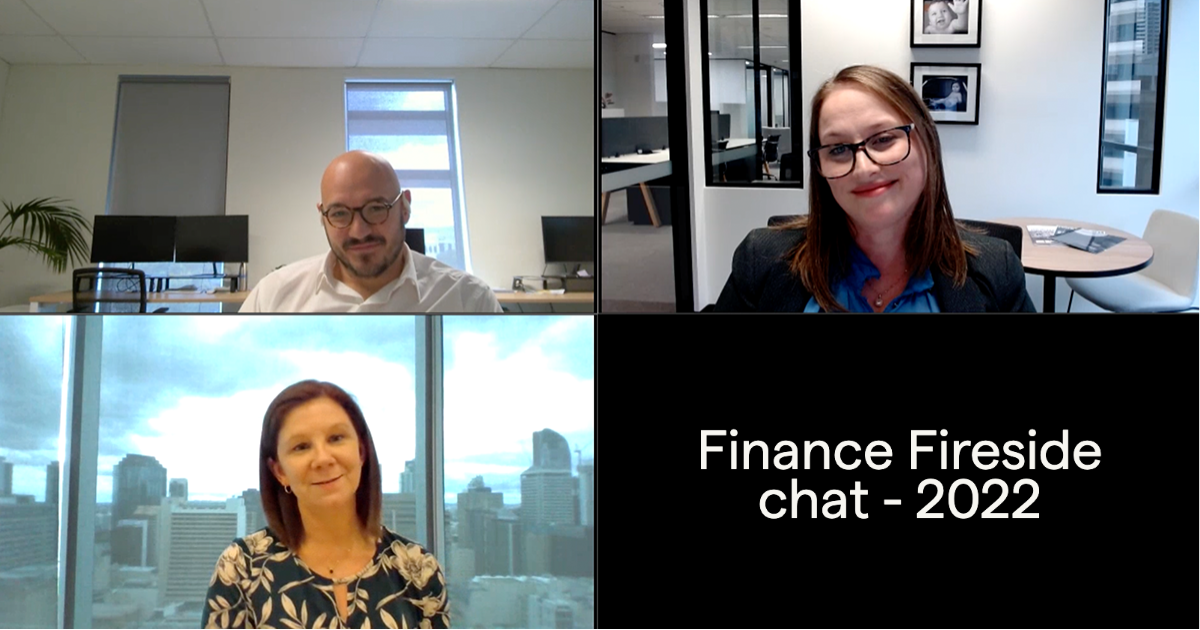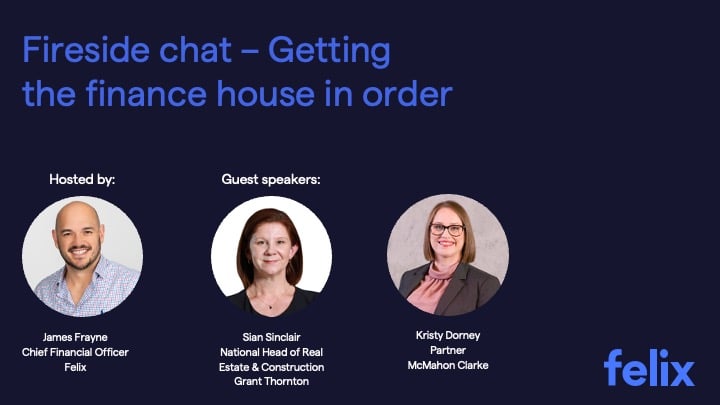It's quite an interesting time at the moment, as we’re moving out of this new phase of the pandemic. The wider economic markets and monetary policy are having a considerable effect on the construction industry, things like interest rates, consumer spending, our supply and demand for materials.
As finance, governance, and risk leaders in our organisations, we need to be aware of what's occurring and how best to equip ourselves and the organisations that we work for to handle those issues moving forward, and position our organisations with the best possible way to navigate through the future.
I recently had the pleasure of discussing this very theme with Sian Sinclair from Grant Thornton and Kristy Dorney from McMahon Clarke. Below is a recap of the session. Feel free to skip to the topic of interest.
- Compliance topics
- Building and construction review
- Project Trust Account
- Short-term challenges
- Contract management
- Long-term challenges
- Innovation & technology
If you’d like to watch the recording, please visit this link.
What are the new compliance topics that executives and finance leaders need to be aware of?
Sian: Well, I suppose it's probably timely to think around what are the ‘right now’ things that people in the finance teams need to be thinking around and some of it is ‘how do I look after and protect the directors of my organisations?’.
One of the key ones, which is time-critical, is around making sure that all of the directors of all the organisations have applied for their directors’ IDs. With particular structures, you can end up with a large number, and even if you're operating out of a trust structure, you still may have corporate trustee where you have directors of those corporate trustees and even super funds need to be aware of.
That's an initiative that the ABRS is now running. So this is all part of that bringing all of the business registers into one place.
It's like if you're a company director, it's like your TFN, so you need to apply for this number because it's going to stick with you for the rest of your life.
And any time that you're acting in a director role, you need to be able to quote this number.
The intention of course is to just kind of manage phoenixing that has been occurring, where we had directors of organisations that were running up debts, closing and then, maybe not long after, starting up a new organisation and going on their merry way. So it's really looking to try and bring that to a close.
The key issue I think is the 30 November date, you really need to have all your directors applying and there are many where you may have an overseas director. They still need to get an Australian DIN and it's a bit harder because they actually have to apply in a paper format and they need to have obtained the appropriate ID to be able to send to the ABRS to actually review that.
That's where I've seen a lot of the difficulties and I've had applications that have been taking 9 to 12 weeks to get processed.
The 30 November date is very quickly approaching. The quickest way to do it is getting online and going through and downloading MyGov ID, etc.
Quite often those entrepreneurs, those directors are too busy and don't have time to even understand why they need a directors’ ID number, let alone go through the process of applying.
Unfortunately, you can't apply for them, and your advisors can't apply for you. You've actually got to go in there and do it yourself. But I recommend some of your directors might need a bit of hand holding to get through that process, and the reason to give them why they have to do this is there're some nasty penalties involved.
If you don't have director ID when required, you've got up to $1.1 million of civil penalties that the ABRS has at their discretion to throw at you.
Obviously, that's on a case by case. There are also criminal penalties involved so it's an important one to make sure that anyone on the board of any of the companies that you're looking after are ticking this one off, and if you're appointing a new director to any of your organisations, they need to have their director ID before they can fill the role of director.
----
The other one I thought might be an interesting one to talk around is director penalty notices.
Just a bit of background: The ATO has power to look to recover certain liabilities. So effectively it's your super, GST and PAYG withholding, and those liabilities can be recovered from the directors personally if the company hasn't paid them.
What it does is the ATO sends a notice out for the same balance that’s owing by the company to each of the directors, so those liabilities run in parallel until payment is made by somebody. But it does mean that your personal assets of the directors are at risk in relation to meeting those liabilities.
In April this year, the ATO sent out 52,000 director penalty notices, which then gives people 21 days to take some action.
And interestingly, that action is either paying in full, getting a payment arrangement in place – it means you need to talk to the tax office and discuss how you're going to meet those liabilities – or it's doing something to the point of placing the company into administration to clear the liability that sits personally with the director.
There's one way you can make sure that the director isn't held liable, and that the liability stays with the company, and that is to make sure your reporting of those liabilities is up to date.
You have a three-month period past the due date to notify the ATO so they can keep track of what that liability really is.
If you're not reporting those liabilities, the liability stays with the director. But if you, as a director, have ensured that the organisation is appropriately reporting, then at least by taking certain actions you can keep the liability with the company.
It is one that can catch people by surprise. Also, if you come in as a new director, you need to take certain actions within that three-month period to make sure you have assessed and are aware of any liabilities, otherwise you can be held personally liable for them.
And leaving as a director and retiring doesn't necessarily get you out of it. Effectively, if those liabilities were accumulated at the time when you were a director, then you can't get out of that.
---
Some of those actions involved may sound very scary, such as placing a company into administration or appointing a restructuring practitioner – but getting some help, external help in, may be one of the various ways that you can look at it and they're available to help manage the time.
Because obviously if you're not able to meet those liabilities, you're clearly having some cash flow issues and you need to look at the structuring of the internal debt and how to manage that, and maybe you need some help to do that.
---
I guess on the ATO, more broadly, there was a nice period during COVID where they did go very softly, but their debt book has grown out incredibly, it's blown out from about $37 billion to about $60 billion, and now they're in the process of recovering that.
Interestingly there's a good chunk of that that's undisputed debt, so it is purely debt that people acknowledge, is owing, just hasn't been paid and they need to put under payment arrangements, etc. They're very aware of the debt book that's blown out and they're kind of taking action on that now and these director penalty notices are certainly one of the vehicles they have for doing that.
But also they're back into the ATO review activity so they have been working their way through a process of reviewing the top 1000 companies, they've moved on now, they've been working their way through the top 500 private groups and looking at how tax governance is managed within those organisations.
They're now on to their next 5000. So that means if you have an organisation and associated organisations who control wealth more than $50 million or turnover over $350 million, any time the ATO could be knocking on your door and it's time for a chat to look at how you as an organisation approach your risk to tax and your obligations to tax.
And we're seeing a huge focus on the governance around tax – making sure that the directors are putting it on their agenda and making sure that there's a strategy around tax and assessing what your tax appetite for risk is and then also how you manage that risk.
Property and construction, unfortunately, hasn't scored so well in some of their review as an industry.
It is going to be an ongoing focus area, unfortunately for this industry, and we've long been known as high consequence taxpayers. It's nice to know we're part of that group, but it's about creating some structure within our organisations that show that we're at least addressing those risks when the time does come, when the tax office knocks on the door.
---
Kristy: Just piggybacking off what Sian said in terms of compliance. I'm not seeing any increase in the level of compliance that’s required, but it's more so there's quite a bit of activity in regulating.
We did have a little bit of a hold from all of the regulators, now everyone’s getting stuck into it.
On a construction basis, you've got the QBCC who are charged with regulating and policing builders, subcontractors and licencing – they've recently undergone a review that was handed down this year.
The whole intent of that was to make them have more teeth and to help.
It's really about understanding what you're already required to do. Make sure that you're sitting down looking at compliance regimes for your licencing on their contract administration side as well. I think that we've had quite a lengthy history of construction contracts being put together and then put in the bottom drawer.
I accept that that's quite often what happens and in the good times, relationships allow that. But at the moment, that's not the case at all. If things do go bad, lawyers, unfortunately, they will sit down and they will look at everything that hasn't been complied with and add that to the list of things to dispute.
Don't make that easy for them. Look at the contract, follow the regimes for variations, extension of time. I think it just takes an extra layer of dispute away if you actually look at the regime and follow it.
Another on the contract side of things. Anyone that's using standard form contracts with consumers and small businesses, there already is a regime in place where if you've got something that's deemed to be an unfair contract term, that will be treated as void as a remedy, but that's never really prevented anyone from having those clauses in their contracts.
Last week a bill has been introduced which is looking at penalising companies for having those clauses in their contracts altogether. So, we're looking at penalties being increased up to $50 million, but also penalties that are associated with your turnover.
From a contract compliance perspective there, it's really important for anyone using those contracts. You will have 12 months from when that bill gets released and to sit down and go through and get some advice on whether you've got clauses in there that will offend those provisions and then work out: Do you need them? Can we frame them differently and get that in order?
Could you talk to us about the building construction industry review that's going on, the objective purpose and progress so far?
Kristy: About two years ago there was a review of the existing legislation in place for the building and construction industry in Queensland, which is pretty comprehensive.
And as part of that there were a few anecdotal comments that perhaps developers might have a part to play in defective work and timing of payments and late payments and non-payment.
There was a legislation amendment which they would do a review.
So, it's not a review of the construction industry as such, but it's a review of developers and how they might influence and impact that industry. And that's been going on for about 11 months now. There was a panel convened and they've spent the last 11 months meeting privately with a whole heap of industry bodies across all of the fields on the property, the subcontractor’s side, the law societies, the financiers.
A report is meant to be handed down at the very latest next month. We were expecting to get a preliminary paper or a public document to come out for consultation, but I think the time might have passed for doing that so next month, we should have some outcome.
But just in terms of the general feel of where that might lead, I know licencing of developers was something that on the outset, late last year everyone was talking about, that might be an outcome of this review. I think it was heartening to hear from the outset that that wasn't the intention of the review.
And I really think that the end product of the review is we do have quite a robust and comprehensive legislative system for Queensland in building and construction.
I think what the outcome might be is really about some industry-led initiatives designed to make sure that people have the opportunity to use the systems that are already in place, the remedies, some education programmes, disclosure. I think that that's where we will land, but we're about a month off from knowing what the outcome of that will be.
--
Sian: It's interesting the New South Wales Government have adopted the approach where it's almost like a voluntary for developers where they, for a fee and they gather information on themselves, and they will basically be transparent with putting forward financial information to demonstrate how robust they are as organisations; to get themselves a rating so that when people are looking for a developer they can look up whether they get the tick or not. But it's all voluntary at this point.
It's obviously the big guys with the deeper pockets are the ones who go first and get the ratings there.
And it's a question of, when it's voluntary how robust is that as a system? But I guess it's a starting point, so it'll be interesting to see if other states start to look at that. I think Queensland went a very intensive approach, but it'll be interesting to see where other states might land.
There's been a lot of talk about project trust accounts, do you have any light you can shed on this topic?
Sian: It's something that's getting more topical other than just in Queensland. Obviously, any organisation that does projects in Queensland needs to be aware of it because they're under it, but WA is now in the process, they're implementing project trust accounts as well.
It's been in play in the NSW but it's more the larger projects, so it's in that bigger project space. We’re now in the point in Queensland where it's pretty much most projects - we're looking at the $3 million currently and then by 2023 it's meant to be all projects over a million, even in the private sector space.
Initially when it was introduced, it was only looking at government projects under a certain threshold, being $10 million.
The intention is around securing payments for subcontractors and there's a lot of legislation that also sits around that.
I think the overarching feeling is that it's a massive amount of administrative burden on the finance teams of particularly the head contractors.
There's a lot of rules where you know when things go wrong, we could have principals that can step in, etc. But the main purpose of it is the head contractor doesn't get paid until all the subbies have been paid. So, it's really trying to protect that.
And if there is a dispute or retentions, they need to now be set off into a separate account, another trust account. Every project has to have its own project trust account, plus you need to have the retention trust account.
On that one, there's audit and review obligations. That's additional administrative costs you've got to manage. Your software has to be able to manage it. You've got to have bank accounts with your software tracking the movement in and out of all of those bank accounts because there's various reporting that has to be done on it.
Finding the software that can manage that is also a challenge. There's training, mandatory training, that has to be undertaken if you are an administrator of a project trust account. It is a massive impact within finance teams of organisations that are now covered under these projects and required to have it, and there's a lot more reporting back and forth, in this instance the QBCC, but it's going be the equivalent in WA etc.
I haven't heard a lot of good feedback around it. Probably in our role and the people that we're talking to within finance teams, they're probably just shaking their head as to the extra work it's creating for them.
--
Kristy: That's absolutely been my experience in talking to people. I don't think that anybody understood including the government - the administrative impact and burden that this would place on the head contractors. There're entire new roles that have been created, new staff that they've had to hire.
In relation to the training that you need to undertake, I'm not actually sure the training’s being released at this stage, but you’re already required to have these trust accounts established and that's why it has been delayed and pushed out to 2023.
It'll be interesting to see if those next two milestones are here if we get further delays on it, but I think looking at the legislation itself as well, there're definitely some gaps and issues in that “nerdy” lawyers have spent a long time trying to make it make sense, and there are parts of it that just don't and some unintended consequences.
I won't get into the detail because I know that's not what this is about, but one interesting thing is that the obligation to establish a project trust account, for the most part sits at that first layer, that head contractor. But if you, for example, have a landowner that appoints a developer, and the developer then appoints a head contractor, then that project trust account obligation sits with the developer, which I don't think was an intended consequence at all.
I know that there is legislation being considered at the moment, which will put it down the chain so that the head contractor does have to be the one to establish a project trust account, but the developer will still have to do it.
I think that that is a bit of an unintended consequence of the legislation, but one that I'm not aware that's going away.
What are you seeing as the key challenges that construction firms will have to face and tackle in the short-term?
Sian: If you were talking to people six months ago, it was all about material costs and delays and that sort of thing.
But what I'm hearing now, and absolutely sitting at round tables these days, it is all about skill shortages and human resources, and that is what’s holding back organisations from growth and even being able to deliver on the pipeline they have. I'm hearing massive pipelines but there's uncertainty on how to get the workforce required to deliver that.
Looking at productivity commission and the extent of government work that's being thrown out there, particularly QLD centric is probably Olympics, but also there's a lot of money being thrown out there for health, education around the country and they're looking at the capacity of the construction industry to actually meet that.
When you look at the general infrastructure spend and the commitments that have been at the federal level and what's expected on a state-by-state basis, and under the current resourcing that we've got, it's just a case of there's not going to be any room for private sector projects because so much of it's going to be swallowed up on government initiatives at this point.
---
The supply chain side of things hasn't gone away, but I am hearing anecdotally the material costs are coming back. I mean we saw Rio Steel and we saw timber at crazy prices. My understanding is that the costs of framing on housings coming well back to where it was. Rio steel prices, at one stage you couldn't get them to lock you in a price for any longer than seven days, but at the moment they're starting to talk about lock-ins for 12-month contracting on prices again.
I think it's more around the delivery and clearing the backlog. There was a lot of people who were, those with the deeper pockets and had the capacity to do so, did a lot of stockpiling and so they've been able to keep going, but you're seeing people who are still doing their orders for materials on jobs that they're just tendering on.
They don't know if they've won the job yet, but they're ordering because they have to allow that lead time.
And logistics, believe it or not, it's the truck drivers and the tradies - are the ones that are really causing the backlogs at the moment.
And then I'd probably throw in weather delays. We all know that we're in for another wet summer. Really looking at what buffer have you built into your contracts for wet weather days and is it enough. Because I think we're going see a lot more than that. I know a lot of people were surprised, thinking they had a pretty fair margin built into their contracts for wet weather delays, but they blew well out in the last 12 months.
--
Kristy: I think from a contracting perspective, everything that you say is absolutely what we're seeing going on as well.
But with getting your construction contracts in place, the issue is if you don't get that signed up immediately once you get your tender, then that price will not be fixed. Whereas in the past, you would get a tender document that had a notice at the bottom that it was valid for 30 days, but actually the parties would go back and forth for months and months and then still look at it at that price.
That's absolutely not the case anymore, and it is being enforced and it has to be enforced because of that volatility and because of all the liquidations that we're seeing. There has been a bit of a push back in that space.
It is heartening to hear that there are some fixed quotes for materials and things that are pushing out now beyond the seven days, but that is the interesting times with the contracting side of things.
Given all of those elements and challenges that construction firms are facing, what are you seeing around the contract management element? Are you seeing more adversarial or collaborative contracting?
Kristy: I know that there's been a lot of discussion, particularly at a government level, but also more broadly about collaborative or alliance contracting.
What that's really talking about is moving away from the fixed price model that has been in place forever and a day; has been the preferred model for financiers and developers but also for contractors, because in the good times fixing the price to do a full design and construction project allows that contractor to increase its profit and to manage that profit.
Fixed price contracting has always been the way, but now, because of all those things that have been raised, we're finding lots of cash flow issues and liquidations in construction. Because those construction projects take 18 months to three years to complete and once you fix the price at the early stage, then with everything that's been going on, you're losing all of that margin at the tail end of it.
Back in the early COVID day, everyone was saying that there needs to be a shift away from the fixed price model. What we're actually seeing isn't a dramatic change, or moving towards a cost plus, which is a more of a reimbursement cost recovery plus a profit margin.
I'm not seeing a dramatic shift towards that extreme end of contracting, but I'm definitely seeing hybrids on that fixed price. There are a number of options available or in fixed price contracting, you already have an ability to agree provisional some items which you don't quite know when you lock it in so you reserve the right to work out what that will cost once you get to that point or once you finish that design element and you can firm that up.
There're also lots of discussion around starting out with an early contractor involvement. Doing that on a cost-plus basis with a view to getting all the design elements locked away so that the contractor is actually in a position to properly know what the cost is going to be, to be able to lock those contracts in and then at that stage converting the contract into a fixed price.
So, lots of different options and importantly lots of different discussions around doing something slightly different from the fixed price model.
Financiers and banks have always been thought to be the roadblocks, doing anything other than fixed price. And perhaps initially when this was raised that was definitely the attitude that was expressed. But very quickly it became apparent that something did need to be done a little bit differently.
I don't think that the outcome of that, I'm not seeing that again shifting towards a dramatic cost-plus style of contracting and not fixing in the price, but it's also not a matter of financiers completely bearing the burden of that risk.
It's a bit of a share around between financiers and the developers. I have heard that there has been some shift towards sharing that risk of the price volatility between the two of them, but then also some of that is in that collaboration that is happening with the builder and some of that is being passed through at that end as well.
We discuss about short term challenges, but taking a longer view into the future, say the next 5-10 years, what are your predictions for the sector and what do you see evolving?
Sian: Well I can't help but have a QLD centric focus here so apologies, but the Olympics doesn't happen every day.
I think Brisbane 2032 gives South East Queensland and the rest of Australia huge opportunities The governments get behind it, so we see a lot of infrastructure spend. We see the eyes of the world on Australia, if not Brisbane, so we see a higher level of consideration about looking at our lifestyle and what opportunities in Australia has to offer. And so, you think it builds a lot of interest and consideration and investment, hopefully, coming into our nation. We need overseas investment.
I'm looking forward to that 10-year runway now to the games and what that means, not just for SE Queensland but all of us.
And a lot of organisations around Australia who can supply into those games and opportunities for that and what that can mean for growth for those organisations.
Obviously, we're in for a bit of a rough ride at the moment, but thankfully this inflationary period and the interest rate has been a very quick uplift. We've gone up very quickly and it just means that rather than death by a thousand cuts, we've just been ripping the Band-Aid.
But it is going to mean organisations having to look at ‘what does this mean for my business’, ‘getting a good understanding of what my cost structure is’, ‘how is this inflationary period affecting what it costs me to service customers and am I building that into my pricing’.
Thinking around efficiencies that we need to gain on: ‘Can we identify any inefficiencies within our business that need to be dealt with?’; ‘Do we, do we need to look at outsourcing for this period, given the tight race [in] labour market constraints’, things like that.
But, I'd like to see a bit of a trend of innovation coming in a bit more and being adopted more broadly, not just in those who were supplying because I think there's plenty of innovation happening within those organisations that are supplying and building and constructing things out there.
I think it's the principals, the financiers. It needs to be the government departments that are prepared to tick off these new innovations and accept them, the financiers who are prepared to fund them.
Rather than just “because we've always used concrete pipes at X diameter”. While there's a shortage of that, maybe we need to think about what a viable alternative is and having the principals, accepting of those alternatives and it's just taking that broader view.
Innovation gets stifled at that funding and sign-off level, but just making sure that kind of continues to build and develop within the industry.
--
Kristy: It is a massive opportunity obviously in the construction industry, but more broadly in the manufacturing industry within Australia.
I know that there is a big push and support from the government to invest in Australian companies, manufacturing in Australia.
I think that that's an exciting opportunity and the real challenge is in next three to five years to deal with all those things that we listed before. Particularly the skill shortage and I think that that will be a really big one there.
There is definitely investment happening in that space from the government level, but it's going to take at least three years to move people through that pipeline and get them performing in the way that they need.
I think that it will be interesting to see where those things move and make sure that we get some real traction and then beyond that massive opportunity in all sectors in Australia.
--
Sian: Yeah, I think we just need to be careful. That consumer confidence doesn't get to knocked by all the press. Everyone’s “Oh, gosh, the house prices have gone down. Oh no”. Well, how far have they gone up in the last 12 months? It's two years, 12 months? There's a certain level of normality we've got to get back to and just making sure that it's not too much of a media beef-up that it does impact consumer confidence.
Sian, you touched on innovation and entrepreneurship before. What do you see about the role of technology over the next 5-10 years in construction? Do you think we'll see a push for increased adoption?
Sian: I think there is innovation happening. It's getting the next level to accept those innovative, alternative products, etc. Whether it be the modular approach to building, or who would have thought timber high rises 10 years ago would become quite accepted, etc.
But it's getting the financiers of those types of projects on board. I think there's a bit of an education journey that people need to take on as well as going through that innovation - the costs to innovate and develop new products.
We deal with a lot of organisations that are putting their time into trying to create efficiencies, but sustainability and the environment and the social impact is such a huge part that ties in with that as well. A lot of the technology advancements are for that purpose.
We're seeing that ESG is really starting to raise in profile within a lot of organisations and technology is a huge part of that.
---
We've got the ATO – our key regulator who is talking about going to real time reporting. You need to have the in-house software to be able to keep up with that. We've now got single touch payroll reporting. We're effectively real time reporting.
They're trying to push to that for GST. They're trying to close in reporting time so that effectively when you get the cash, you're basically in time, it's time to pay it.
I think from the ATO and the regulators’ perspective, they're looking at a huge amount of technology advancement and an adoption of software and digitisation within businesses.
--
Kristy: And similarly, all the licencing regimes we have - credit and financial services, building and construction licencing, all of the compliance requirements - attached to those licence are all being reviewed at the moment. There's a lot of activity going on there.
Getting that in order, reviewing your systems, anything that you can do technology-wise to streamline that process is really important.
To watch the full discussion, please click here.

Recent Articles
2025 in review: Milestones, insights and achievements
2025 – a year of that brought meaningful developments for Felix as we continue to address the evolving needs of organisations navigating complex supply-chain environments.
Top 10 reasons for a centralised vendor database
As organisations grow, so does the complexity of managing vendor relationships. Many still rely on spreadsheets or siloed systems, which can lead to inefficiencies, data inconsistencies, and compliance risks. A centralised vendor database offers a smarter, more scalable solution that brings structure, visibility, and control to procurement operations.
Here are the top 10 reasons why centralising your vendor data is a strategic move.
Five ways poor contract storage could be costing your organisation money
Contracts are the backbone of every business relationship – legally binding documents that define expectations, responsibilities, and value.
But what if the way your organisation stores those contracts is quietly costing you money?
Let's stay in touch
Get the monthly dose of supply chain, procurement and technology insights with the Felix newsletter.







